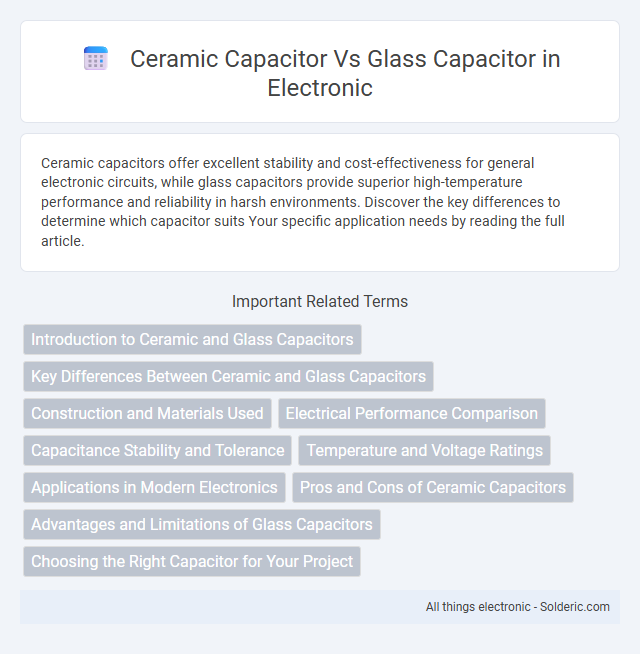Ceramic capacitors offer excellent stability and cost-effectiveness for general electronic circuits, while glass capacitors provide superior high-temperature performance and reliability in harsh environments. Discover the key differences to determine which capacitor suits Your specific application needs by reading the full article.
Comparison Table
| Feature | Ceramic Capacitor | Glass Capacitor |
|---|---|---|
| Dielectric Material | Ceramic | Glass |
| Temperature Stability | Moderate | High |
| Voltage Rating | Low to Medium (up to ~5 kV) | High (up to several kV) |
| Capacitance Range | Few pF to uF | pF range, usually lower values |
| Losses (Dissipation Factor) | Higher | Very Low |
| Frequency Response | Good up to MHz range | Excellent, suitable for high-frequency applications |
| Physical Robustness | Fragile but common surface mount | Very robust and stable |
| Cost | Low | High |
| Typical Applications | General electronics, decoupling, filtering | High precision circuits, RF, microwave, aerospace |
Introduction to Ceramic and Glass Capacitors
Ceramic capacitors utilize a ceramic material as the dielectric, offering high permittivity and stability across a wide frequency range, making them ideal for decoupling and filtering applications. Glass capacitors feature a glass dielectric, providing superior insulation resistance, temperature stability, and low loss characteristics, commonly used in precision circuits and high-frequency applications. Both types differing mainly in dielectric properties influence their electrical performance, reliability, and suitable application environments.
Key Differences Between Ceramic and Glass Capacitors
Ceramic capacitors use ceramic materials as the dielectric, offering high capacitance values, excellent stability, and cost-effective performance suited for general electronics. Glass capacitors feature glass dielectrics providing superior insulation, exceptional temperature stability, and resistance to moisture, making them ideal for precision applications. Your choice depends on the specific requirements for capacitance, tolerance, and environmental durability in your electronic design.
Construction and Materials Used
Ceramic capacitors feature layers of ceramic dielectric material sandwiched between metal electrodes, providing compact size and high capacitance stability. Glass capacitors use a glass dielectric with metal electrodes sealed hermetically, offering exceptional temperature stability and low loss characteristics. Your choice depends on the desired performance, with ceramic capacitors excelling in general applications and glass capacitors preferred in precision, high-reliability environments.
Electrical Performance Comparison
Ceramic capacitors exhibit high dielectric constant values, resulting in superior capacitance per volume and excellent frequency response, making them ideal for high-frequency applications. Glass capacitors offer exceptional electrical stability and low dielectric loss, maintaining consistent capacitance under extreme temperature and voltage conditions, which is crucial for precision circuits. The leakage current in glass capacitors is significantly lower than in ceramic types, enhancing reliability in critical electrical performance scenarios.
Capacitance Stability and Tolerance
Ceramic capacitors offer moderate capacitance stability with typical tolerance ranges between +-5% to +-20%, making them suitable for general applications where precise capacitance is not critical. Glass capacitors provide superior capacitance stability and low tolerance, often within +-1%, ensuring minimal variation under temperature and voltage changes, ideal for high-precision circuits. Your choice should prioritize glass capacitors when stable capacitance and tight tolerance are crucial for performance.
Temperature and Voltage Ratings
Ceramic capacitors typically offer stable performance with temperature ratings ranging from -55degC to 125degC and can withstand voltages up to several kilovolts, making them suitable for a wide range of electronic applications. Glass capacitors provide superior temperature stability, often operating reliably from -55degC to 250degC, and feature higher voltage ratings exceeding 5 kV, which makes them ideal for high-voltage and high-temperature environments. The dielectric properties of glass capacitors result in low loss and excellent insulation resistance compared to ceramic types, enhancing their performance in extreme conditions.
Applications in Modern Electronics
Ceramic capacitors are widely used in modern electronics for decoupling, filtering, and timing applications due to their high dielectric constant, stability, and compact size, making them ideal for consumer electronics, automotive systems, and RF circuits. Glass capacitors offer superior temperature stability, high insulation resistance, and low loss, making them suitable for precision circuits, aerospace electronics, and high-frequency microwave applications. Both capacitor types are essential in ensuring reliable performance across diverse electronic devices, with ceramic capacitors dominating mass-market applications and glass capacitors preferred for high-reliability environments.
Pros and Cons of Ceramic Capacitors
Ceramic capacitors offer high stability, low cost, and excellent reliability, making them ideal for general-purpose applications in electronic circuits. They provide low equivalent series resistance (ESR) and self-inductance, supporting high-frequency performance but may suffer from capacitance variation with temperature and voltage, limiting precision in some circuits. Your choice depends on whether you prioritize cost-effectiveness and compact size (ceramic) or superior thermal stability and longevity of glass capacitors.
Advantages and Limitations of Glass Capacitors
Glass capacitors offer superior temperature stability, low dielectric absorption, and excellent insulation resistance compared to ceramic capacitors, making them ideal for precision applications and harsh environments. However, glass capacitors tend to have lower capacitance values and higher manufacturing costs, limiting their use in mass production and general-purpose circuits. Their mechanical brittleness also requires careful handling during assembly and operation.
Choosing the Right Capacitor for Your Project
Ceramic capacitors offer high dielectric strength, low inductance, and cost-effectiveness, making them ideal for high-frequency and general-purpose applications. Glass capacitors provide superior stability, extremely low leakage current, and excellent temperature characteristics, suitable for precision circuits and harsh environments. Selecting between ceramic and glass capacitors depends on factors such as required capacitance stability, operating temperature range, frequency response, and budget constraints.
Ceramic capacitor vs glass capacitor Infographic

 solderic.com
solderic.com